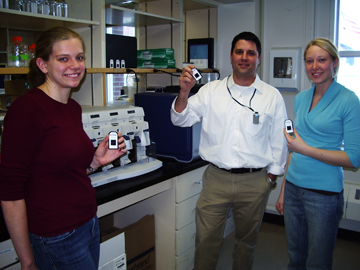 |
Holding DNA microarray chips used in their research are (from left to right) UNMC Graduate student Kelsi Anderson, Assistant Professor Paul Dunman, Ph.D., who co-authored the Science paper, and Research Technologist Lisa Kuechenmeister. |
The findings are published in the Feb. 15 issue of Science, one of the world’s most prestigious science journals. Paul Dunman, Ph.D., UNMC assistant professor of pathology and microbiology, co-authored the article along with of one his graduate students.
The information could lead to a new way to treat staph infections. Most current antibiotics must get into bacteria to work. A therapeutic that could starve bacteria to death without necessarily having to be absorbed inside the cell would be a significant advantage since many antibiotics fail if they can’t get into the cell.
Senior and lead author of the study, respectively, were Vanderbilt University Medical Center’s Eric Skaar, Ph.D., assistant professor of microbiology and immunology, and Brian Corbin, Ph.D., postdoctoral fellow. They reasoned that proteins present at the site of a staph infection might be important to the battle between the bug and the immune system, and might therefore make good targets for therapeutics. They took advantage of the fact that staph forms abscesses – pimple-like infected areas – in internal organs like the liver.
 |
Eric Skaar, Ph.D. |
“It basically starves the bacteria by stealing its food,” Skaar said.
“The work is a phenomenal merger of several cutting edge-technologies, which collectively allow an unprecedented view of the host-pathogen interface,” Dr. Dunman said. “The Vanderbilt team was using some very cutting edge technology and we have some very different cutting edge technology. When you merge the two, you can ask some very important questions in the lab.
“They identified a protein that targets staph at abscess sites and kills the bacteria. Our technology was used to confirm their hypothesis,” Dr. Dunman said.
Last year, UNMC researchers started collaborating on their shared interest of studying staph, a bacteria that has increasingly become resistant to antibiotics, and is reported to cause more deaths per year than HIV.
“Paul is an internationally recognized authority on the regulation of staph gene expression,” said Dr. Skaar of Vanderbilt. “His expertise in DNA microarray technologies allowed us to unequivocally establish that staph exposed to calprotectin are starved for manganese and zinc.”
The UNMC team used technology Dr. Dunman discovered in 1999, which helps scientists understand how the bacteria behaves at the abscess site (infection site).
The technology takes a snapshot of what’s happening in the cells to tell scientists what genes are or are not being expressed. Dr. Dunman, whose team works with 24 labs around the world, has developed a database of 150 different strains of staph DNA on microarrays, which tells all the genes present or absent and how these genes are expressed during infection. Previously, the conditions could only be mimicked in lab cultures.
The technology is important for vaccine discovery and antibacterial drug discovery and can potentially be a diagnostic, Dr. Dunman said.
Staph is the leading cause of pus-forming skin and soft tissue infections, the leading cause of infectious heart disease, the number one hospital-acquired infection, and one of four leading causes of food-borne illness.
Kelsi Anderson, a graduate student at UNMC working in Dr. Dunman’s lab, is also a co-author of the paper. She went to Vanderbilt to train researchers on the UNMC technology, then Vanderbilt scientists visited UNMC to do follow up experiments. “The Vanderbilt team was especially pleased that we were willing to collaborate with them,” she said.
Dr. Dunman and Anderson knew the research they were involved in with Vanderbilt was important. “I think everybody involved realized it was going to be pretty groundbreaking,” he said. “Both our team and the Vanderbilt team have some exciting data to share with people. We have developed this wonderful collaboration that has produced four papers and a fifth is on its way.”
Dr. Dunman has been studying staph for eight years. The focus of his research is to find new antibiotics for the treatment of staph, in particular methicillin-resistant Staphylococcus aureus (MRSA). His group is working on a unique approach no one else in the country is working on — targeting proteins that are involved in a novel staph biological process.
Other collaborators included the University of Aberdeen, Scotland, the University of Muenster, Germany, and Applied Speciation and Consulting in Washington. The research was supported by the Searle Scholars Program, the Burroughs Wellcome Fund, the National Institutes of Health and the Department of Defense.